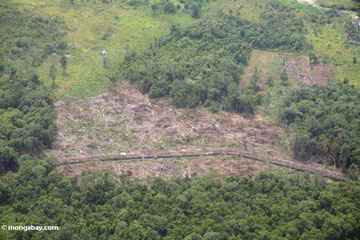Dutch will demand rainforest-friendly palm oil
Dutch will demand rainforest-friendly palm oil
mongabay.com
April 27, 2007
In a report scheduled to be released today, the Dutch government will outline criteria for growing biofuels in a more sustainable manner. The guidelines will be closely watched by the rest of Europe, which is currently struggling with the environmental pros and cons of large-scale energy crop production, especially in ecologically-sensitive areas like the Amazon and Indonesian rainforests.
Draft versions of the “Cramer Commission report” acquired by the Associated Press and Wetlands International, an environmental group, suggest that criteria include a ban on bioenergy crops that “contribute to deforestation, deplete reservoirs of carbon captured in the earth, compete with food crops, degrade soil or water supplies, upset biodiversity, or displace local populations” (Associated Press).
The criteria could have a large impact on how countries like Indonesia produce biofuels. The Netherlands is currently Europe’s biggest importer of palm oil, most of which comes from Indonesia where oil palm plantations are often grown on deforested lands, especially carbon-rich peatlands. Wetlands International estimates that destruction of these ecosystems may release as much as 2 billion tons of carbon dioxide per year or 8 percent of total anthropogenic emissions of the greenhouse gas.
 Rainforest clearing for an oil palm plantation in Borneo. Photos by Rhett A. Butler. |
Wetlands International said the criteria could help promote sustainable palm oil production and reduce carbon emissions from biofuels production.
“These Dutch criteria could have a great impact,” the group said in a statement.
“The rapidly growing demand for palm oil as a bio-fuel is largely the result of supportive legislation in various countries. Now the Dutch governmental committee recognises that palm oil production on peat leads to excessive CO2 release, subsidies and targets will likely halt and pressure will grow to make palm oil production more sustainable. The EU is working on a new bio-fuel Directive, including criteria for sustainability. The decision from the Netherlands as the first EU-member to present its criteria are therefore encouraging. The UK is currently working on bio-fuel certification systems.”
Marcel Silvius, a researcher with Wetlands International, added that his group is working to develop greener palm oil.
“We are working with palm oil based industry in the Netherlands to find ways to promote sustainable palm oil production and appropriate certification schemes,” he told mongabay.com.
Related articles
Eco-friendly palm oil could help alleviate poverty in Indonesia. Palm oil is quite obviously not a failure as a biofuel—it is derived from perhaps the most productive energy crop on the planet. A single hectare of oil palm may yield nearly 6,000 liters of crude biodiesel. In comparison, soybeans and corn generate only 446 and 172 liters per hectare, respectively. The problem with palm oil is not its yield, but how it is produced. Presently much of the world’s palm oil is coming out of the forests of Southeast Asia—increasingly in the biodiverse rainforests of Indonesia. Oil-palm cultivation has expanded in Indonesia from 600,000 hectares in 1985 to more than 6 million hectares by early 2007, and is expected to reach 10 million hectares by 2010. With such rapid growth—and room for expansion—Indonesia is expected to displace Malaysia as the world’s largest producer of palm oil within a few years. Environmental groups say that clearing for oil-palm plantations is directly threatening key habitat for such endangered species as the orangutan, the Bornean Clouded Leopard, and the Sumatran Rhino as well as exacerbating illegal logging already rampant across the region.
Palm oil doesn’t have to be bad for the environment. As traditionally practiced in Southeast Asia, oil-palm cultivation is responsible for widespread deforestation that reduces biodiversity, degrades important ecological services, worsens climate change, and traps workers in inequitable conditions sometimes analogous to slavery. This doesn’t have to be the case. Following examples set forth by the Roundtable on Sustainable Palm Oil and firms like Golden Hope Plantations Berhad, a Malaysian palm-oil producer, oil palm can be cultivated in a manner that helps mitigate climate change, preserves biodiversity, and brings economic opportunities to desperately poor rural populations.
Why is palm oil replacing tropical rainforests? In a word, economics, though deeper analysis of a proposal in Indonesia suggests that oil-palm development might be a cover for something more lucrative: logging. Recently, much has been made about the conversion of Asia’s biodiverse rainforests for oil-palm cultivation. Environmental organizations have warned that by eating foods that use palm oil as an ingredient, Western consumers are directly fueling the destruction of orangutan habitat and sensitive ecosystems. So why is it that oil-palm plantations now cover millions of hectares across Malaysia, Indonesia, and Thailand? Why has oil palm become the world’s number one fruit crop, trouncing its nearest competitor, the humble banana? The answer lies in the crop’s unparalleled productivity. Simply put, oil palm is the most productive oil seed in the world. A single hectare of oil palm may yield 5,000 kilograms of crude oil, or nearly 6,000 liters of crude.